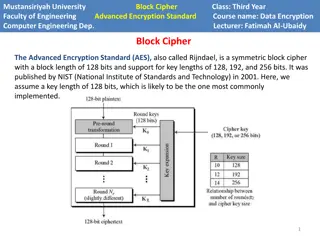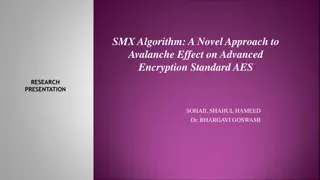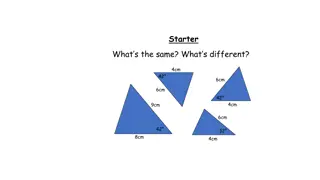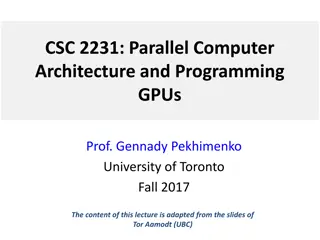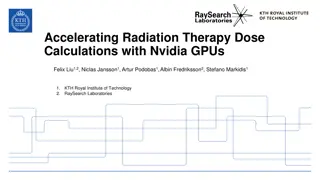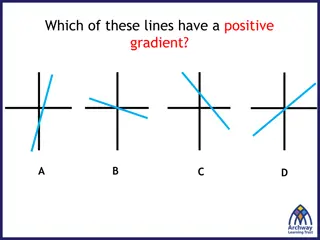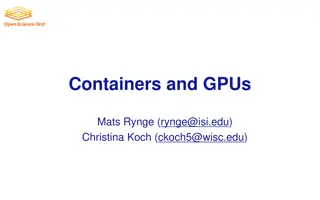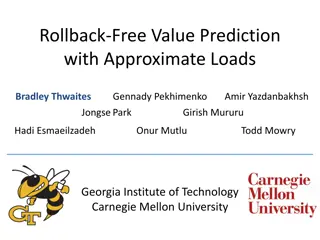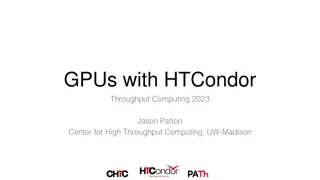Scatter-and-Gather Revisited: High-Performance Side-Channel-Resistant AES on GPUs
This research focuses on enhancing the security of AES encryption on GPUs by introducing the Scatter-and-Gather (SG) approach, aimed at achieving side-channel resistance and high performance. By reorganizing tables to prevent key-related information leakage, the SG approach offers a promising solution to mitigate side-channel attacks. The study explores various aspects, including memory coalescing, bank conflict resolution, and the implementation of AES on GPUs. Through a comprehensive analysis, the researchers illustrate the effectiveness of SG in bolstering the security of cryptographic algorithms on GPU platforms.
Download Presentation

Please find below an Image/Link to download the presentation.
The content on the website is provided AS IS for your information and personal use only. It may not be sold, licensed, or shared on other websites without obtaining consent from the author.If you encounter any issues during the download, it is possible that the publisher has removed the file from their server.
You are allowed to download the files provided on this website for personal or commercial use, subject to the condition that they are used lawfully. All files are the property of their respective owners.
The content on the website is provided AS IS for your information and personal use only. It may not be sold, licensed, or shared on other websites without obtaining consent from the author.
E N D
Presentation Transcript
Scatter-and-Gather Revisited: High-Performance Side-Channel-Resistant AES on GPUs Zhen Lin, Utkarsh Mathur, Huiyang Zhou North Carolina State University 1
Introduction GPUs have been widely used for performance acceleration ~10x speedup for AES encryption algorithm Side channel attacks make the crypto algorithms vulnerable Timing attacks Access-driven cache attacks Our work: Scatter and Gather (SG) approach Goal: side-channel resistance & high performance Idea: reorganize the tables so that table lookups won t leak key-related information 2
Outline Introduction Background Scatter-and-Gather (SG) Approach Security Analysis SG with Shared Memory Evaluation Conclusions 3
Outline Introduction Background Memory coalescing Bank conflict AES Implementation on GPUs Timing attacks Access-driven cache attacks 4
Memory Coalescing Line 0 0x2 0x3 0x0 0x1 tid 0 tid 1 tid 2 tid 3 0x4 Line 1 Line 0, 1, 2 0x2 Line 0 Line 1 0x6 0x7 0x4 0x5 0x7 Line 1 0xB Line 2 0xA 0xB 0x8 0x9 Line 2 Warp Coalescing unit L1 data cache Different addresses -> different # cache lines -> different access latency 5
Bank Conflict 0x3 0x0 0x1 0x2 tid 0 tid 1 tid 2 tid 3 0x4 Bank 0 0x2 Bank 2 0x7 0x4 0x5 0x6 Two-way bank conflict 0x7 Bank 3 0xB Bank 3 0x8 0x9 0xA 0xB Warp Bank 0 Bank 1 Bank 2 Bank 3 Shared memory Different addresses -> different # bank conflicts -> different access latency 6
AES Implementation on GPUs Symmetric-key block-cipher algorithm, AES-128 Each thread encrypts a 128-bit block, 10 rounds OpenSSL implementation based on table lookups Small tables, can fit in L1 cache or shared memory 7
Timing Attacks on GPUs [Jiang16] ???Ciphertext T-table, 1024-byte size ???Input text of last round Round key ?? ?4 ?? ?? ???= ?4?? ??? ?? Last round: ?? ??? ?? Coalescing tid 0 tid 1 Addr0 Addr1 Different access latency 1 ~ 8 (1024/128) cache line accesses unit . . . tid 31 Addr31 Assume 128-byte cache line Jiang et al., A complete key recovery timing attack on a GPU, HPCA 16 8
Timing Attacks on GPUs [Jiang16] Source: G. Kadam, RCoal: Mitigating GPU Timing Attack via Subwarp-based Randomized Coalescing Techniques , HPCA 18 Server Plaintexts Plaintext # 1 Plaintext # 2 Plaintext # 3 Ciphertexts Ciphertext # 1 Ciphertext # 2 Ciphertext # 3 Time duration time1 time2 time3 Correct Key Correct Key?? K1 , K2, ,Ki, Key guesses Attacker timestart- timestop = time1 9
Timing Attacks on GPUs [Jiang16] Last round: ???= ?4?? ??? ?? ?? Time (real key) ???= ?4 1[?? ??? ? ?] Inverse table lookup: ? ? High correlation? Table lookup address Guessed key ???= ?4? ? ??? ? ? ? ? Redo table lookup Time (guessed key) Table lookup timing information leaks key! 10
Access-Driven Cache Attacks Prime-and-Probe on CPUs Prime: attacker fills all cache sets Idle: waits for victim to access cache Probe: attacker monitors which cache sets were accessed by victim Set # => table index => key GPU allows multiple kernels co- run on the same GPU core Potential threat Victim Attacker Set 0 Set 1 . . . Set x Data cache 11
Outline Introduction Background Scatter-and-Gather (SG) Approach Security Analysis SG with Shared Memory Evaluation Conclusions 12
Scatter-and-Gather (SG) Approach Goals Side channel resistance High performance Software design Table lookups is vulnerable Idea Re-organize the table so that table lookups won t leak the key 13
Motivation 256 entries (1024 bytes) 4 bytes 4 bytes 4 bytes 1 byte . . . ??? ?4 ?4?3 & 0?000000?? ?? 1024 bytes, 8 lines Assume 128-byte cache line size . . . ?40 ??? ?40?3 256 bytes 256 bytes, 2 lines 14
Scatter-and-Gather (SG) Approach 1024 (256x4) bits = 128 bytes 32 bits Line 0 Line 1 Line 2 Line 3 Line 4 Line 5 Line 6 byte 0 0 1 2 byte 1 256 entries . . . byte 2 byte 3 Line 7 255 ?4???? & 0x0000FF00 0 1 2 255 . . . 4 bits 1 ~ 8 lines 2 x 1 line Constant latency! 15
For Different Cache Line Sizes 32 bits Cache line size Column width SG version 0 1 2 8 bits SG-8 256 bytes 256 entries . . . . . . 4 bits SG-4 128 bytes 2 bits SG-2 64 bytes 255 1 bit SG-1 32 bytes width 16
Outline Introduction Background Scatter-and-Gather (SG) Approach Security Analysis SG with Shared Memory Evaluation Conclusions 17
Resistance to Access-Driven Cache Attacks Table index Original table Cache line # => table index Miss => index was accessed Re-organized table Cache line # is independent on table index Miss won t reveal table index SG is resistant to access-driven cache attacks Motivation of SG for CPUs* 0 ~ 31 32 ~ 63 64 ~ 95 96 ~ 127 128 ~ 159 160 ~ 191 192 ~ 223 224 ~ 255 Line 0 Line 1 Line 2 Line 3 Line 4 Line 5 Line 6 Line 7 Table index 0 1 2 255 . . . [*] Blomer et al., Analysis of countermeasures against access driven cache attacks on AES, SAC 07 18
Resistance to Cache Timing Attacks # keys can be recovered in 100,000 samples Model Architecture L1D line size SG-x TeslaK40 GTX980 GTX1080 RTX2080 Tesla K40 Kepler 128 bytes SG-4 16 16 16 16 Base SG-8 SG-4 SG-2 SG-1 GTX 980 Maxwell 32 bytes SG-1 16 0 0 0 16 16 16 16 16 16 16 16 16 0 0 0 GTX 1080 Pascal 32 bytes SG-1 RTX 2080 Turing 128 bytes SG-4 All 16 keys can be recovered within 1000 samples! Why? 19
A New Side Channel // Launch kernel with 32 threads idx = random[tid]; // Random indices (0~31) start = clock(); dummy = input[idx] ; // Load one byte per thread dummy ^= 0x1; // Wait for load to be finished latency = clock() - start; Index pattern Latency Access the same cache line 0, 1, 2, , 31 (linear) 97 cycles x, x, x, , x (uniform) 97 cycles 1 cache line access constant access latency, vulnerable to timing attacks! Random_1 97 cycles Random_2 98 cycles Random_3 99 cycles Random_4 100 cycles 20 Results on GTX 1080
Outline Introduction Background Scatter-and-Gather (SG) Approach Security Analysis SG with Shared Memory Evaluation Conclusions 21
SG with Shared Memory Row 0 0x3 0x0 0x1 0x2 Row 1 1 row access == Constant latency 0x7 0x4 0x5 0x6 Row 2 0x8 0x9 0xA 0xB Bank 0 Bank 1 Bank 2 Bank 3 Confirmed with experiments! Shared memory 22
SG with Shared Memory 32 bits 1024 (256x4) bits Assume 128-byte row size Row 0 Row 1 Row 2 Row 3 Row 4 Row 5 Row 6 Row 7 0 1 2 256 entries . . . 255 4 bits 0 1 2 255 Shared memory Original Table Re-organized Table 23
Resistance to Timing Attacks # keys can be recovered in 100,000 samples Model Architecture Shared mem row size SG-x TeslaK40 GTX980 GTX1080 RTX2080 Tesla K40 Kepler 256 bytes SG-8 16 16 16 16 Base SG-8 SG-4 SG-2 SG-1 GTX 980 Maxwell 128 bytes SG-4 0 0 0 0 15 0 0 0 14 0 0 0 16 0 0 0 GTX 1080 Pascal 128 bytes SG-4 RTX 2080 Turing 128 bytes SG-4 SG with shared memory is resistant to timing attacks! 24
Resistance to Access-Driven Cache Attacks Yes! Shared memory cannot be evicted 25
Outline Introduction Background Scatter-and-Gather (SG) Approach Security Analysis SG with Shared Memory Evaluation Conclusions 26
Methodology AES: 128-bit ECB mode Baseline: OpenSSL ported to CUDA 4 NVIDIA GPUs: Tesla K40 (Kepler), GTX 980 (Maxwell), GTX 1080 (Pascal), RTX 2080 (Turing) Open source on Github https://github.com/zhenlin36/scatter_gather_aes_cuda 27
Results on GTX 1080 Global memory Shared memory SG-4_last Baseline SG-4_last SG-4_all SG-4_first+last Baseline SG-4_all SG-4_first+last Throughput (Gbps) 400 400 Throughput (Gbps) 300 300 200 200 100 100 0 0 Baseline: OpenSSL SG_last: SG for last round SG_all: SG for all 10 rounds SG_first+last: SG for first and last round All known attacks target first or last round Similar performance compared to baseline Shared memory has higher performance 28
Overall Performance GPU SG_first+last throughput % Baseline Tesla K40 84 Gbps 105% GTX 980 152 Gbps 99% GTX 1080 301 Gbps 104% RTX 2080 261 Gbps 90% Intel Xeon CPU (E5-1607) with build in AES instructions: 27 Gbps throughput 29
Outline Introduction Background Scatter-and-Gather (SG) Approach Security Analysis SG with Shared Memory Evaluation Conclusions 30
Conclusions Side channel attacks make GPU vulnerable SG approach reorganizes the tables so that the key- dependent information becomes not observable A new side channel on GPU L1 data cache SG with shared memory is resistant to side channels High performance using SG_first+last 31
Table-Based AES Implementations Sbox AES: original implementation All rounds: 8-bit memory accesses T-table AES: optimized for 32-bit processors (OpenSSL) First 9 rounds: 32-bit memory accesses Last round: 8-bit memory accesses SG-based AES: expensive for 32-bit memory accesses First 9 rounds: SG-based Sbox Last round: SG-based T-table 33
A New Side Channel // Launch kernel with 32 threads idx = random[tid]; // Random indices (0~31) start = clock(); dummy = input[idx] ^ 0x1; // Load one byte per thread latency = clock() - start; Access the same cache line Index pattern Latency 1 cache line access constant access latency, fixing the coalescing is not sufficient! 0, 1, 2, , 31 (linear) 97 cycles x, x, x, , x (uniform) 97 cycles Random_1 97 cycles 4,4,8,4,4,4,4,8,4,4,4,8,4,4,4,4,8,4,4,4,4,8,4,4,4,4,4,8,4,4,4,4 Random_2 98 cycles 0,1,2,3,4,5,6,7,8,9,10,11,12,13,14,15,16,17,18,19,20,4,22,23,24,25,26,27,28,29,30,31 Random_3 99 cycles 11,8,5,29,5,1,0,19,25,13,2,19,15,28,28,10,27,30,14,0,3,6,20,23,5,3,21,15,17,27,30,28 Random_4 100 cycles 3,6,11,6,25,0,6,30,25,11,28,29,9,0,7,10,8,29,14,24,11,26,8,7,27,13,24,23,4,17,10,7 34 Results based on GTX 1080





